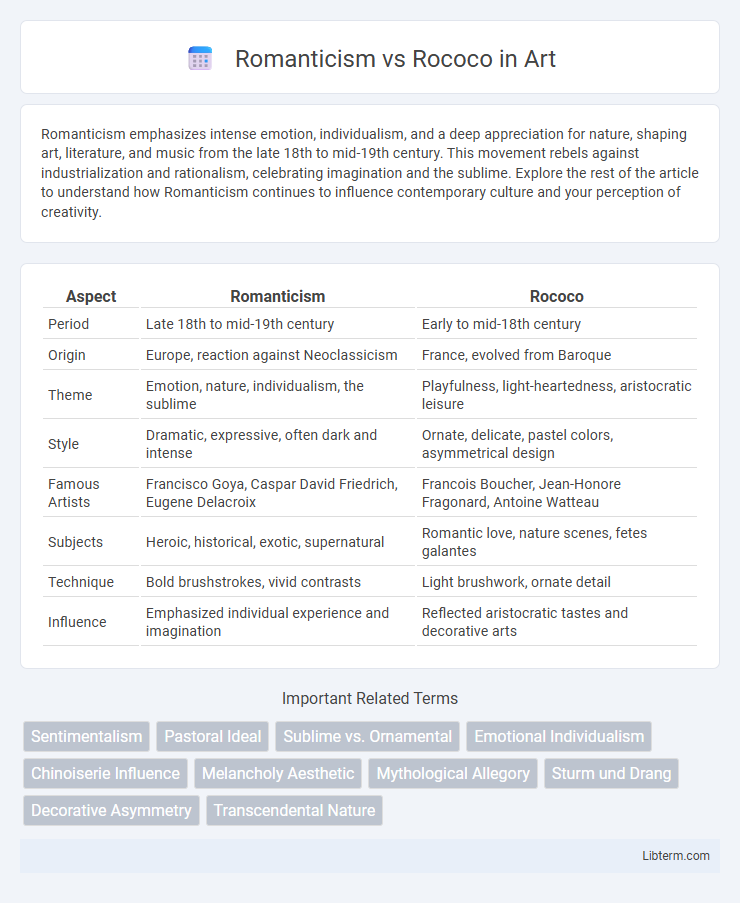Romanticism emphasizes intense emotion, individualism, and a deep appreciation for nature, shaping art, literature, and music from the late 18th to mid-19th century. This movement rebels against industrialization and rationalism, celebrating imagination and the sublime. Explore the rest of the article to understand how Romanticism continues to influence contemporary culture and your perception of creativity.
Table of Comparison
| Aspect | Romanticism | Rococo |
|---|---|---|
| Period | Late 18th to mid-19th century | Early to mid-18th century |
| Origin | Europe, reaction against Neoclassicism | France, evolved from Baroque |
| Theme | Emotion, nature, individualism, the sublime | Playfulness, light-heartedness, aristocratic leisure |
| Style | Dramatic, expressive, often dark and intense | Ornate, delicate, pastel colors, asymmetrical design |
| Famous Artists | Francisco Goya, Caspar David Friedrich, Eugene Delacroix | Francois Boucher, Jean-Honore Fragonard, Antoine Watteau |
| Subjects | Heroic, historical, exotic, supernatural | Romantic love, nature scenes, fetes galantes |
| Technique | Bold brushstrokes, vivid contrasts | Light brushwork, ornate detail |
| Influence | Emphasized individual experience and imagination | Reflected aristocratic tastes and decorative arts |
Origins and Historical Context
Romanticism originated in the late 18th century as a reaction against the Enlightenment's rationalism and the Industrial Revolution's mechanization, emphasizing emotion, individualism, and nature. Rococo emerged earlier in the early 18th century within the French aristocracy, characterized by ornate decoration, lightness, and playful themes, reflecting the period's social decadence and the decline of the Baroque style. The historical context of Romanticism is rooted in political upheavals like the French Revolution, while Rococo flourished during the peaceful reigns of Louis XV and XV, symbolizing aristocratic luxury.
Key Philosophies and Ideals
Romanticism emphasized emotion, individualism, and the sublime, valuing nature's power and human imagination as responses to the Industrial Revolution's rationalism. Rococo, rooted in the Enlightenment, celebrated ornamental elegance, lightness, and playful themes, highlighting aristocratic refinement and superficial beauty. Romanticism's key ideal of authentic expression sharply contrasts with Rococo's focus on decorative artifice and social pleasure.
Artistic Characteristics of Romanticism
Romanticism is characterized by its emphasis on intense emotion, individualism, and the sublime beauty of nature, contrasting sharply with the ornamental elegance and playful themes of Rococo. Artists like Caspar David Friedrich and Eugene Delacroix employed dramatic color contrasts, dynamic compositions, and evocative imagery to convey passion and spiritual depth. The movement rejected Rococo's elaborate decoration, instead favoring bold brushstrokes and powerful narratives that express human experience and imagination.
Defining Features of Rococo Art
Rococo art is characterized by ornate decoration, light pastel colors, and playful themes often centered around love, nature, and mythology. Its defining features include intricate details, asymmetrical designs, and a sense of movement and fluidity, creating an elegant, whimsical atmosphere. This style contrasts sharply with the emotional intensity and dramatic contrasts found in Romanticism.
Major Artists and Influential Works
Major artists of Romanticism, such as Francisco Goya and Eugene Delacroix, created emotionally charged works like "The Third of May 1808" and "Liberty Leading the People," emphasizing dramatic expression and individualism. Rococo artists including Jean-Honore Fragonard and Francois Boucher produced elegant and ornamental paintings like "The Swing" and "Madame de Pompadour," highlighting lightness and decorative charm. These divergent styles reflect Romanticism's focus on intense emotion and nature versus Rococo's playful, aristocratic refinement.
Themes and Subject Matter
Romanticism emphasizes intense emotion, individualism, and the sublime aspects of nature, often exploring themes of heroism, nationalism, and the supernatural. Rococo centers on lighthearted, decorative themes such as love, leisure, and aristocratic extravagance, featuring playful, ornate compositions with pastel colors. While Romanticism embraces dramatic, often dark or melancholic subject matter, Rococo celebrates elegance, frivolity, and sensual pleasure.
Techniques and Materials Used
Romanticism emphasized expressive brushwork, rich color palettes, and dramatic contrasts using oil paints on canvas to evoke intense emotions and individualism. Rococo employed delicate, intricate brushstrokes with pastel hues, often using tempera and oil on wood panels or walls to create lighthearted, ornamental designs. Techniques in Rococo favored asymmetry and elaborate detailing, while Romanticism utilized bold, dynamic compositions to convey passion and sublime nature.
Influence on Literature, Music, and Architecture
Romanticism profoundly influenced literature by emphasizing emotion, individualism, and nature, producing iconic works from poets like Wordsworth and composers such as Beethoven who expanded expressive depth in music. Rococo, by contrast, shaped literature and music with its light, ornate style, evident in the elegant, playful compositions of composers like Francois Couperin and the decorative, whimsical architectural designs seen in buildings such as the Amalienburg in Munich. Architecturally, Romanticism favored dramatic, picturesque forms that conveyed intense emotion, exemplified by the Gothic Revival, whereas Rococo embraced intricate details, pastel colors, and asymmetry to create intimate, ornamental spaces.
Legacy and Cultural Impact
Romanticism shaped modern artistic expression by emphasizing emotion, individualism, and nature, influencing literature, music, and visual arts with lasting cultural significance. Rococo's intricate, decorative elegance left a legacy in interior design and ornamental arts, reflecting 18th-century aristocratic taste and influencing Baroque and Neoclassical styles. Both movements contributed distinctive aesthetics and philosophies that continue to inspire contemporary art and cultural discourse.
Comparing Romanticism and Rococo Today
Romanticism emphasizes emotional intensity, individualism, and the sublime in nature, contrasting sharply with Rococo's ornate, playful, and decorative style rooted in 18th-century aristocratic elegance. Today, Romanticism's influence is evident in contemporary art and literature through its focus on personal expression and dramatic themes, whereas Rococo remains primarily valued for its historical and aesthetic heritage in interior design and fine arts. The enduring legacy of Romanticism fosters cultural movements centered on authenticity and emotional depth, while Rococo appeals to collectors and enthusiasts of elaborate craftsmanship and classical refinement.
Romanticism Infographic

 libterm.com
libterm.com